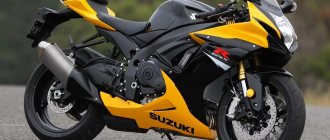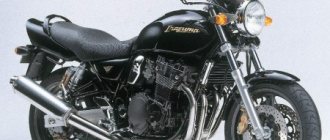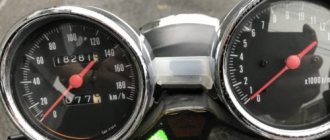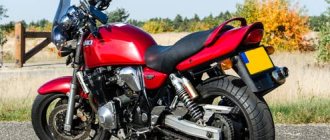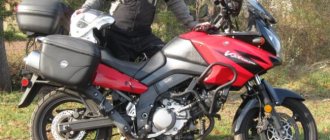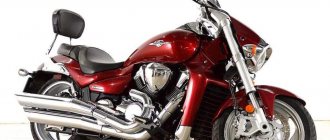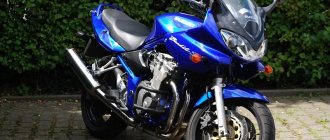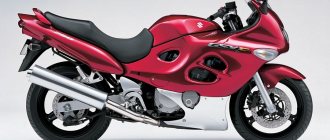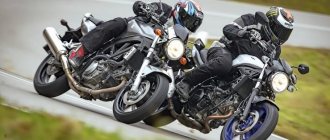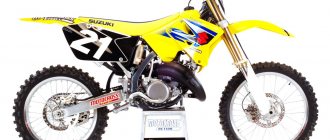The legendary Suzuki GSX R-750 has been shaking roads around the world since the mid-80s. It was then that the Suzuki company took an unprecedented step by releasing civilian sportbike, developed on the basis of racing motorcycles. At that time, championships were still held in the capacity of up to 750cc, so other Japanese companies took up the initiative. Competition forced Suzuki to continue to develop the model, and now the Jixer is the only one of its kind, because all other participants dropped out of the race after the cancellation of the world championships in 750 cc.
Design
Since the release of the first GSX750R, the model has already gone through a dozen restylings, but each generation of the motorcycle corresponded to the spirit of its time. The first copies look alien in modern realities, but the latest generations were designed by leading designers, and they look great. The generation currently in production was released in 2011, and we can expect another update in the coming years. There have been no significant design changes since 2007, when the GSX R 750 K7 was released.
Specifications
In modern realities, the GSXR 750 remains the only intermediate-sized sportbike, although there are classics and streetfighters with similar technical characteristics. But both them and the Suzuki sportbike can only be recommended for fairly experienced pilots . High power requires honed skills, a cool head and responsibility. However, the Suzuki GSX 750's technical characteristics are generally well balanced, so you can quickly get used to the bike.
Engine
The first Jixer engines used air-oil cooling, but it was decided long ago to abandon it in favor of liquid cooling. In 2008, the S-DMS (Suzuki Drive Mode Selector) system appeared as an additional option, allowing you to choose from three engine operating modes. On the last two generations, the 749 cc 16-valve engine produces 150 hp. power and 86.3 Nm of torque available at 11,200 rpm . The maximum speed of the GSX 750 reaches 280 km/h , and it accelerates from 0 to 100 km/h in 3.08 seconds .
Transmission
The six-speed transmission has undergone many changes over the past decades. It works properly, a little rough, but it's easy to get used to after a few days of driving. But it is trouble-free, problems with it are extremely rare. The efficiency of the transmission has increased even more since 2006, when, along with the new engine, the sportbike received a slipper clutch.
Chassis and brakes
"Jixers" have always been equipped with light alloy frames , which reduced the weight of the motorcycle. The latest generation Suzuki GSX R750 has a curb weight of only 190 kg , and a dry weight of even less, and this is an excellent indicator. The brakes are also decent, especially since 2008 when Japanese engineers began installing the new Brembo braking system . Early examples had problems with the effectiveness of the brakes - there were objectively not enough of them on the track, but this is far in the past. As well as rigid suspensions, since the Suzuki GSX 750 has long acquired a fully customizable chassis, which can be easily adjusted in garage conditions. The last update took place in 2011, when, along with a new Showa fork, the sportbike received a new frame with a pendulum.
Electronics
The latest generations of Suzuki bikes have become noticeably more technically complex. For full diagnostics, you need to connect a laptop with special software to the motorcycle via a bus, which is available only from dealers. But the old “Jixers” are equipped with a minimal amount of electronic filling, and any motor electrician can easily understand them.
Weight and dimensions
Suzuki engineers managed to achieve their goal and reduce the weight of the motorcycle to a virtual minimum. The Suzuki GSX 750 weighs comparable to the 600 and has similar dimensions, while possessing the dynamics of a “liter” sportbike. This provides it with significant advantages both in the city and on the track, and this is why the GSX-R 750 is loved by hundreds of thousands of bikers.
Controllability
Having ridden a fresh Suzuki GSX 750, you understand that you won’t be able to find fault with its handling. The bike behaves so predictably on the road, and so obediently does everything the pilot wants, that it can be called a standard in this parameter. But the same cannot be said about the “Jixers” of the 90s - they had their own problems, such as a tendency to wobble and mediocre feedback from the front wheel, especially on roads with poor-quality surfaces.
Fuel consumption
The motorcycle has been equipped with fuel injection since 1998, and the introduction of a fuel injection system has reduced fuel consumption. On modern Suzuki GSXR 750 it averages just under 6 liters per hundred , although there is practically no upper limit - with aggressive driving, consumption increases rapidly . Old carburetor models are noticeably more voracious, and consume 1-1.5 liters more, while at least preferring AI-95. Although some owners of old “Jixers” fill it with AI-92, and, according to reviews, the motorcycles digest it normally.
General description of the latest version
The last significant innovations affected the model in 2010. The motorbike received a more advanced motor and advanced electronics. It is impossible not to note the real revolution of that time: the ability to select the engine operating mode, a suspension with many settings, as well as a slipper clutch. The new product is based on an aluminum diagonal frame. The car retains the same excellent handling, so the pilot can be confident in it, regardless of driving conditions. Thanks to the suspension customization function, the rider and the motorcycle become one. The total weight of the new product in running order is 190 kilograms, while the dimensions, respectively, in length, width and height are 2030x710x1135 millimeters.
Repair and tuning
Owners of the GSX-R 750 will be pleased with the fact that there are enough spare parts for their steel horses. There are both original Suzuki parts on sale and a lot of analogues, which are often not inferior in quality to components sold by official dealers.
Repair
Maintaining old Jixers yourself is not difficult. In recent generations, Suzuki engineers have significantly improved the design, at the same time making it more complex, so for a number of issues you will have to contact authorized dealers. But this trend affects all modern motorcycles and cars.
Spare parts
The selection of spare parts is very large, although the necessary parts are often not available. The problem can be solved by ordering from foreign online stores. This will save your budget, but you will have to wait for delivery, which may take a month or two. Modern Suzuki GSX 750s cost about the same amount to maintain as the old ones.
Tuning
Probably no sportbike in the world has as much tuning as the Suzuki GSX-R750. This is doubly true for previous generations, which were notorious for insufficiently effective brakes with sluggish feedback. Therefore, many sportbikes of this model on the secondary market are sold in a form modified by previous owners, with reinforced brake hoses, new brake cylinders and calipers.
Brief history of the model
- 1985 - start of production and sales. First generation.
Model
: Suzuki GSX-R750 (Japan, etc.).
Factory designation
: GSX-R750F.
- 1986 - no significant changes.
Model
: Suzuki GSX-R750 (Japan, etc.).
Factory designation
: GSX-R750G.
- 1987 - no significant changes.
Model
: Suzuki GSX-R750 (Japan, etc.).
Factory designation
: GSX-R750H.
- 1988 - restyling of the model. Second generation.
Model
: Suzuki GSX-R750 (Japan, etc.).
Factory designation
: GSX-R750J.
- 1989 - no significant changes. The limited edition GSX-R750R is introduced.
Model
: Suzuki GSX-R750 (Japan, etc.).
Factory designation
: GSX-R750K.
- 1990 - restyling of the model. Third generation.
Model
: Suzuki GSX-R750 (Japan, etc.).
Factory designation
: GSX-R750L.
- 1991 - restyling of the model. Fourth generation.
Model
: Suzuki GSX-R750 (Japan, etc.).
Factory designation
: GSX-R750M.
- 1992 - restyling of the model. Fifth generation.
Model
: Suzuki GSX-R750 (Japan, USA, etc.).
Factory designation
: GSX-R750N.
- 1993 - no significant changes.
Model
: Suzuki GSX-R750 (Japan, USA, etc.).
Factory designation
: GSX-R750P.
- 1994 - no significant changes.
Model
: Suzuki GSX-R750 (Japan, USA, etc.).
Factory designation
: GSX-R750R.
- 1995 - no significant changes.
Model
: Suzuki GSX-R750 (Japan, USA, etc.).
Factory designation
: GSX-R750S.
- 1996 - restyling of the model. Sixth generation
.
Model
: Suzuki GSX-R750 (all markets).
Factory designation
: GSX-R750T.
- 1997 - no significant changes.
Model
: Suzuki GSX-R750 (all markets).
Factory designation
: GSX-R750V.
- 1998 - restyling of the model. Seventh generation.
Model
: Suzuki GSX-R750 (all markets).
Factory designation
: GSX-R750W.
- 1999 - no significant changes.
Model
: Suzuki GSX-R750 (all markets).
Factory designation
: GSX-R750X.
- 2000 - restyling of the model. Eighth generation.
Model
: Suzuki GSX-R750 (all markets).
Factory designation
: GSX-R750Y.
- 2001 - no significant changes.
Model
: Suzuki GSX-R750 (all markets).
Factory designation
: GSX-R750K1.
- 2002 - no significant changes.
Model
: Suzuki GSX-R750 (all markets).
Factory designation
: GSX-R750K2.
- 2003 - no significant changes.
Model
: Suzuki GSX-R750 (all markets).
Factory designation
: GSX-R750K3.
- 2004 - restyling of the model. Ninth generation.
Model
: Suzuki GSX-R750 (all markets).
Factory designation
: GSX-R750K4.
- 2005 - no significant changes.
Model
: Suzuki GSX-R750 (all markets).
Factory designation
: GSX-R750K5.
- 2006 - restyling of the model. Tenth generation.
Model
: Suzuki GSX-R750 (all markets).
Factory designation
: GSX-R750K6.
- 2007 - no significant changes.
Model
: Suzuki GSX-R750 (all markets).
Factory designation
: GSX-R750K7.
- 2008 - restyling of the model. Eleventh generation.
Model
: Suzuki GSX-R750 (all markets).
Factory designation
: GSX-R750K8.
- 2009 - no significant changes.
Model
: Suzuki GSX-R750 (all markets).
Factory designation
: GSX-R750K9.
- 2010 - no significant changes.
Model
: Suzuki GSX-R750 (all markets).
Factory designation
: GSX-R750L0.
- 2011 - restyling of the model. Twelfth generation.
Model
: Suzuki GSX-R750 (all markets).
Factory designation
: GSX-R750L1.
- 2012 - no significant changes.
Model
: Suzuki GSX-R750 (all markets).
Factory designation
: GSX-R750L2.
- 2013 - no significant changes.
Model
: Suzuki GSX-R750 (all markets).
Factory designation
: GSX-R750L3.
- 2014 - no significant changes.
Model
: Suzuki GSX-R750 (all markets).
Factory designation
: GSX-R750L4.
- 2015 - no significant changes.
Model
: Suzuki GSX-R750 (all markets).
Factory designation
: GSX-R750L5.
- 2016 - no significant changes.
Model
: Suzuki GSX-R750 (all markets).
Factory designation
: GSX-R750L6.
- 2017 - no significant changes.
Model
: Suzuki GSX-R750 (all markets).
Factory designation
: GSX-R750L7.
- 2018 - no significant changes.
Model
: Suzuki GSX-R750 (all markets).
Factory designation
: GSX-R750L8.
- 2019 - no significant changes.
Model
: Suzuki GSX-R750 (North America, Australia).
Factory designation
: GSX-R750L9.
- 2020 - no significant changes.
Model
: Suzuki GSX-R750 (North America, Australia).
Factory designation
: GSX-R750M0.
- 2021 - no significant changes.
Model
: Suzuki GSX-R750 (North America, Australia).
Factory designation
: GSX-R750M1.
- 2022 - no significant changes.
Model
: Suzuki GSX-R750 (North America, Australia).
Factory designation
: GSX-R750M2.
Motorcycle modifications
The first GSX R 750 was a racing bike slightly adapted for public roads. Engineers equipped it with the latest technology - an aluminum frame, powerful brakes with 4-piston calipers, an anti-dive system and much more, which in 1985 was a real innovation. Since then, the sportbike has been continuously improved and refined, but several main milestones can be identified, before and after which the motorcycle is very different:
- 1989. Release of a single-seat racing modification of the GSX-R750R with a retuned engine and all the improvements available at that time.
- 1990. The appearance of an inverted fork instead of the usual “telescope”.
- 1992. Completely new liquid-cooled engine with increased torque and power.
- 1996. Introduction of the Suzuki Ram Air Direct (SRAD) inertial charging system and the appearance of settings for the front fork of the motorcycle. Instances of the next model year were named Suzuki GSX R 750 SRAD.
- 1998. Replacing Mikuni carburetors with an injector, increasing the maximum engine power.
- 2000. Deep reworking of the Suzuki Jixer 750 motorcycle - new wheels, frame, plastic, brakes, exhaust and injector.
- 2004. Generation K4 – modified engine with titanium valves and increased to 147 hp. power, as well as a completely new design.
- 2006. The all-new GSX 750 K6 arrives, with a new frame, transmission and engine.
- 2008. With the release of the GSX 750 K8, the Drive Mode Selector system with three available engine operating modes is introduced for the first time. This is the only difference from the GSX R 750 K7, which went into production a year earlier.
- 2009. The latest generation of “K”, in this case – K9. All newer copies receive the letter L in the name.
- 2011. Weight reduction thanks to a redesigned frame and swingarm, plus a new Showa fork.
Suzuki music (GSX-R750)
text text from Motorreview
: Nadezhda Osipova
Suzuki GSX-R750: 749 cm3, 140 hp, 270 km/h, $ 8000, 2000 onwards.
Back in 1996, I had the opportunity to talk in an informal setting with an elderly Finn, who was blown by some unknown wind into a Moscow bike show. The conversation was not that long, but very informative. Waving a half-bucket can of beer, a Finnish pensioner said: “In Finland I have GSX-R!” The following phrase determined my life course for the coming five years: “I love Suzuki music!” In confirmation of these words, a very respectable guy hummed very naturally, almost perfectly representing the throttle in all gears, right up to fifth.
It was this demonic howl that sounded in my ears when, five years later, in a snowy parking lot in the center of Moscow, I met a practically new 750 Jixer. The price, taking into account the fact that it was the beginning of December and there were 1,500 kilometers on the odometer, turned out to be simply magical, and a couple of days later the wonderful creation of Japanese engineers was driving to my home in an old Transit. I want to say that the short wheelbase of modern sportbikes gives a big advantage not only in handling on the road, but also in turning such a motorcycle on the stairwell of a Khrushchev building, as well as in maneuvering in the corridor of a small apartment. The transportation losses consisted only of a broken front turn signal, and this was not a big disappointment. All the same, the huge standard “flashers” cause only problems: even if you put the motorcycle on its side in place, the thick leg breaks through the fairing. Therefore, I personally prefer simple overhead turn signals, which were immediately purchased for three kopecks in one of the many Moscow retail outlets. An air K&N was also added to the minimum tuning kit - just to avoid the hassle of replacing every 5,000 kilometers. And reinforced brake hoses - just for beauty.
By the way, don’t believe anyone who says that a motorcycle in an apartment is a source of problems and a gasoline stench. You just need to plug the gas tank ventilation pipe and insert a common dishwasher sponge into the muffler, and nothing will bother you. Not to mention the psychotherapeutic effect of personal equipment located in close proximity to the owner. And it doesn’t matter that indelible marks from the side step remain on the new carpet, and an experienced friend who installed an alarm right at the storage site covered the same carpet with tin. But by the beginning of the season, I was already confidently using all the switches and stopped straining because even in overalls, boots, a helmet and with a three-liter jar of sauerkraut in the back seat, I could only reach the floor while standing on tiptoes. An important element of preparation for the start of operation was regular meditation on the enormous power of the engine and self-persuasions such as “do not open the gas more than halfway for the first month.” As subsequent events showed, a month turned out to be too short a time.
The first week of driving was full of discoveries. Firstly, no extremes in planting. Most foreign testers reported an extremely cramped driving position, too-high pegs and an overly hard seat. I’ll be honest, I haven’t found anything like it so far. Maybe it’s because of my short stature, but for my 164 cm, the layout is ideal: my knees fit into the recesses on the tank, I don’t have to dive behind the wheel, and the fifth point gets no more tired than on any other motorcycle. It’s just difficult to reach the ground, but with a normal sense of balance, touching the toes of one foot is enough.
Secondly, no extraordinary power was found in the engine. True, at first. Because, as planned, I didn’t turn it above 7000. And it feels... Like I'm riding a trolleybus. The acceleration seemed so smooth and even. It was even a little frustrating, because I was expecting something completely different - a nervous motor with “arrivals”. But the sadness quickly passed when I began to notice the readings of not only the tachometer, but also the numbers that the “non-acidic” size liquid crystal speedometer showed. Because where the Yamaha Fazer 600 (my previous motorcycle) delivered 120 km/h, this thing showed all 180 km/h and with absolutely similar sensations. In short, it was unrealistic to “beat” the device.
The third point... came the understanding of controllability. Before that, I only owned motorcycles with steel frames. All of them, and especially the cheerful Fazer, were guilty of excessive gutta-perchiness in corners. The Jixer, as stiff as a log (the suspensions, of course, were tightened almost to the limit by the previous owner), rode as if on rails both during active lane changes and in a straight line, through all the pothole repairs and the not-so-smooth newly built super-interchanges. Here we cannot fail to mention the standard steering damper, which, although it has no adjustments, does its job perfectly.
The wonderful stiffness of the suspension on the Moscow streets showed its other side on the road to Odessa. After 200 km of the route to Bryansk, I had three serious steering wobbles with an amplitude of 60 degrees, a dozen unpleasant jumps over some concrete patches and a growing desire to turn towards Moscow - out of harm’s way. It was great luck that my fellow travelers had strong nerves and a Leatherman at hand: to the accompaniment of my nervous cries, all the necessary cogs from the “nowhere else” position were turned counterclockwise three-quarters of a turn, and the remaining 3,800 kilometers of the trip turned out to be much more comfortable.
Unfortunately, the self-confidence that built up upon arriving home did not lead to anything good: on a not too fine June day, an elderly horseman in a “six” turned right from the middle lane, which prevented me from overtaking on the right while speeding. I was stuck at a traffic light directly in front of a stationary police checkpoint, followed by evacuation to the Sklifosovsky Institute. “Jixer” was much more lucky: having driven onto the lawn, he fell on his side without encountering any obstacles. A little short of reaching 10,000 mileage, the season was closed at the very beginning. Winter brought the bike a new yellow-silver color, xenon lights and a Gianelli muffler. By the way, the coloring was non-standard from the very beginning: the original fairing struck me with its pristine integrity and was removed and hidden away immediately after purchase. Instead, they installed a domestic analogue, painted in a beautiful orange and black color scheme with maximum approximation to the original color scheme. The tank turned out to be the wrong color, and a roadside sewing shop for leather seats concocted a quite decent “leatherette” cover for it, which I’ve been driving with for three years now. The operation of changing the color cost $550 including plastic - we saved a lot on the qualifications of the painter. This doesn’t bother me: the motorcycle should ride well, but it can look average so that people don’t get jealous.
I installed the xenon “crystal blue” light solely for the sake of beauty and only in the low-range mode: with it, motorists can clearly see the motorcycle at any time of the day, and the standard long-range light was left for country night walks. The aluminum “end” of Gianelli came to me from the Russian circuit championship, from where it was fired for being lackluster. It’s just louder than the standard one and oval, and there’s no “+3 strength” or “-7 kege” for you. The main thing is that I am quite happy with it. I think it makes sense to pour money into a famous exhaust if you are doing deep tuning of the engine, but I don’t have such a task yet, and I don’t have the funds either. Well, also, to replace those killed in the accident, very small rear turn signals from the Louis catalog and tall MRA Racing sports glass were added, which were very useful when measuring the maximum speed in a group on the way to St. Petersburg.
There is a wonderful place near Novgorod - an ideal European highway in the middle of the forest, no turns, no traffic lights, and so on for eight kilometers. The speedometer quite briskly dialed 275, then 274, then 275 again, and so blinked back and forth until the end of the dyno section. It was sad to see all sorts of “blackbirds” leaving into the distance. And the glass, by the way, died at the end of the season when a businesswoman with a folder in her hands jumped out right in front of me on Barrikadnaya Street and rushed off into the distance without any apology. You know, the front wheel breaks off on the paving stones downhill in the rain. So it blew up... But on the asphalt, even in a rainstorm, in a rut and with a clearly visible cord at the rear, the motorcycle rides very well and predictably - the 1000 kilometers of the return road from the Latvian vacation confirm this. True, the high-voltage xenon unit, which was designed for a warm and dry existence under the hood, died in the rain. The unit that replaced it under warranty underwent a waterproofing course like your submarine, and is still working.
There was another incident with the electrics. One fine day, the FI light began to blink, which, despite the name (Fuel Injection), works as a diagnostic lamp for everything. But the blinking was so chaotic and illogical that it was not possible to match it with the error codes described in the instructions. Well, okay, as they say, a good knock will come out on its own. And he got out in the middle of a working day in the middle of Leningradsky Prospekt: the engine simply turned off out of the blue and stopped showing signs of life, despite a perfectly working starter and a full tank of gasoline. After 20 minutes of methodically examining everything in a row, it turned out that the very sensor that turns off the motorcycle when it falls fell out of the mount. As soon as it was pushed into its rubber clamp with the right end up, everything worked, and the ill-fated lamp no longer bothered me.
In the middle of summer, I wanted to play with the characteristics of the engine, fortunately, the electronic filling of the motorcycle allows you not to get into the engine, but simply plug a connector from a clever device into the brain and allow experienced guys to get creative without leaving the dyno. The guys played a lot with the power and torque curves, settling on the option “rich the mixture and add horses from above.” They brought it up to 126 against the original 120 (on the rear wheel), but nothing comes out of nowhere, and such a dip appeared on the middle ones that even the “arrival” that came later was not at all pleasing. Still, starting from 3000 and not falling below 7000 is more suitable for the track, and in traffic jams there is no particular thrill in driving like this, so I had to replay everything back, leaving only a slight enrichment at idle and “lower” to compensate for the “end” setting and filter.
Towards the end of the season, an unpleasant surprise occurred - the brakes began to feel strange. Dashing guys on similar motorcycles have previously persistently asked whether I had enough efficiency of standard mechanisms - to be honest, I did, because due to physical weakness in my right hand after an injury, I prefer not just to press the handle, but also to actively stomp the paw, that is, to brake engine. But the ambush only manifested itself during smooth decelerations, when there seemed to be no need to push back as hard as possible. That is, you want to slow down a little due to the brakes, but the required thing does not happen. The sensei, scratching their heads, pointed to the brake pads labeled racing, which supposedly do not have time to heat up when braking and therefore do not grip. However, having estimated that this is hardly possible during city driving, when 30 seconds ago you switched from fourth to first, and right now you just need to hold your horses, a full inspection of the brake mechanisms was carried out. The reason for the ambush turned out to be very sad: the fastening clamp was lost, and the metal braid of the hose rubbed against the wing. In this place, when braking, a small but nasty hernia grew, which stole much-needed meters of braking distance. The hose, of course, was immediately re-routed and changed, and the list of winter work included the installation of a tuning brake machine - just in case. The season was smoothly closed with the number 27650 on the odometer. It's time to do something with the bike.
I didn’t want to go too far into the consumable engine-running jungle, so it was decided to make do with little expense: install an automatic chain lubrication system for the lazy Scottoiler, and even heated handles. A strange choice for a sportbike, would you say? Maybe so, but I like driving the Jixer into the distance no less than around the city. And if Suzuki engineers went to great lengths to make it an excellent tool for active driving in heavy traffic, then you can modify it a little for travel yourself. And the central case, by the way, does not fit on it - there is nowhere to attach the platform. So I will continue to drive with a small bag in the back seat and a very small bag on the tank, and no cloth side bags. In my opinion, hanging them on a jixer is the same as loading an Arabian stallion like a market donkey. And it’s his thoroughbredness that I like. And, of course, Suzuki music.
Superbike Suzuki GSX-R750 model 2006
In 2006, the latest version of the legendary GSX-R750 continues to lead the way in technology. This bike combines the controlled torque and wide, smooth power distribution of a heavyweight machine with the compact size and easy handling of a midweight bike. Now the motorcycle has become even more compact. More powerful. Aerodynamics have improved.
Legendary sports bike
In the 21st century, the new Suzuki GSX-R750 appears in the guise of “The One And Only” - the one and only - as all possible competing companies focused on the production of motorcycles of the 600 and 1000 class. Having taken the “golden mean”, the GSX-R750 is guaranteed to take a leading position in any race, on any track. The superiority in power will leave 600-ton owners far behind, and riders of “liter” sportbikes will only have to envy its benchmark agility and acceleration.
Exactly 21 years ago, back in 1985, the first copy of the production Suzuki GSX-R750 - an almost exact copy of the grand prix motorcycle of those times - took to the world's racing tracks. From that time on, the GSX-R motorcycle series began its life, which later became legendary, and with it a new class of motorcycles - Supersport. The revolutionary Suzuki GSX-R750 motorcycle forever changed production car racing. In all countries of the world, these motorcycles filled the technical pits of tracks, and motorcycle racers on the GSX-R750 fought for victory. The car dominated the racing so convincingly that other brands were forced to leave the 750cc class. cm, since they could not compete with Suzuki. 750 cc class gradually left the schedules of world motorcycle championships, thereby opening up unprecedented opportunities for participants in amateur motorcycle racing or sophisticated connoisseurs of sports motorcycles.
When the GSX-R750 first appeared more than two decades ago, it defined an entirely new category of motorcycle: the true racing replica. For over 20 years, the GSX-R750 has been the link between the race track and the streets.
Over these decades, Suzuki has managed to establish the image of not only innovators, but class leaders - by launching motorcycles in the 1000 and 600 cc class, which are still considered the benchmark.
The GSX-R750's exclusivity lies in its unique embodiment of unrivaled power, traction and acceleration in an exceptionally light and compact 600-class sportbike chassis. The design of the motorcycle impresses with improved aerodynamics, which also provides efficient air delivery. The frame and swingarm, made of black aluminum, also add aggressiveness to the overall design of the motorcycle. The braking system of 4-piston radial calipers is identical to that used on motorcycles of the royal racing Moto GP.
This decision made it possible to abandon the use of dia. discs. 320 mm in favor of discs dia. 300 mm, while maintaining excellent braking performance. The stylish LED brake light is not only a tribute to fashion, but also a concern for the safety of riders - because their response time is 10 times less than traditional lamps.
In the manufacture of the engine of the new GSX-R750, a lot of the latest and ultra-light materials were used, for example, aluminum, titanium, and their alloys, instead of the previously used steel. Thanks to this, it was possible to reduce inertia, which provided more precise control over the operation of the valves, especially at high speeds. 25% less engine energy is now used to open the valves, delivering more power and torque to the rear wheel.
The engine is now equipped with ventilation holes designed to reduce internal pressure and resistance to piston movement, which is especially important at high speeds. Cold starting of the engine is now easier due to the installed AFIS (Auto Fast Idle System), which controls the operation of the valves depending on the coolant temperature. The injection system control processor is now more powerful (32 bits instead of 16). Its memory capacity has been increased from 98 to 256 kB. The front suspension now consists of an inverted fork, previously only found on the GSX-R1000. The diameter of the rear monoshock absorber with progressive characteristics has been increased from 14 to 16 mm.
Indeed, having gone through more than 20 years of victories and achievements, the GSX-R750 has become an exclusive sports bike. Many years of successful performances in motorcycle racing around the world have allowed us to introduce the latest engineering solutions. In fact, the purpose of participation in motorsports was not to win prizes on the podium, but to approbate and test materials, developments and solutions that were revolutionary for their time, in order to implement them on production motorcycles of the legendary GSX-R series as quickly as possible. Although there was still one more goal - to gain the glory of the winner, indescribable joy for the heights achieved, which the owners of the new GSX-R750 can now be fully proud of.
The GSX-R's advertising slogan, "Own the Race Track," is based on fact. When you think of the GSX-R75O, you immediately think of a race bike with lights that offers the best balance of engine and chassis performance.
Equipped with all the necessary road equipment, the Suzuki GSX-R750 is made for victory so that you leave all your rivals behind!
Suzuki GSX-R750 - no winners!
Features of the new GSX-R750
New engine
The all-new, compact and lightweight four-stroke, liquid-cooled, four-cylinder engine is designed to reduce overall machine weight, optimize combustion efficiency and power distribution.
Modified cylinder head with a narrow valve seat angle allowing for a more compact combustion chamber with a higher compression ratio (12.5:1), large intake and exhaust ports for improved intake and exhaust efficiency and increased power output.
The valve pistons have been increased in size to accommodate the increased camshaft operation.
Lightweight titanium valves with steel alloy springs and aluminum spring retainers, with hollow, thin-walled shafts reducing weight and inertia.
Lightweight forged aluminum alloy pistons with short skirts, sidecuts and anti-friction coating, with stronger, shot-blown chrome-molybdenum steel connecting rods.
One-piece top-crankcase cylinder block with larger (39mm) vent holes between cylinders, reducing crankcase pressure and reducing mechanical losses.
The tapered, larger, dual-chamber (50mm) throttle body features Suzuki's SDTV valve system as well as two multi-hole injectors per cylinder for optimal throttle performance and response.
The crankshaft is a forged steel design with a new balance shaft that reduces vibration at high engine speeds.
The crankshaft and transmission shafts have been repositioned to create a more compact engine design, and the engine itself has been moved slightly forward, resulting in straighter and shorter intake and exhaust manifolds.
A new clutch with a reverse torque limiter allows for smoother downshifts; The clutch is matched to a modified six-speed transmission with revised gear ratios and improved shift forks.
The innovative new SAES (Suzuki Advanced Exhaust System) system with a new under-seat muffler and the SET (Suzuki Exhaust Tuning) system improves mass centralization, provides excellent aerodynamics, improves characteristics at lower speeds.
A large, high-volume trapezoidal-shaped radiator ensures effective engine cooling; The radiator is equipped with a compact fan that improves air flow.
The new ISC (Idle Speed Control) system improves cold starts and stabilizes engine speed under various conditions.
The SRAD (Suzuki Ram Air Direct) system delivers cool, pressurized air into the airbox at highway speeds, improving engine efficiency and throttle response.
Test results for the new GSX-R750
New chassis
The all-new, ultra-light frame is constructed entirely from aluminum castings and is engineered to provide optimal rigidity, unrivaled precision and maximum cornering performance.
New reinforced aluminum alloy rear swingarm provides increased rigidity; The swingarm axle size has increased to 25mm and the swingarm is now 38mm longer, giving the rider better feel and increased rear wheel grip.
The new RM-Z450-style rear suspension linkage features a forged aluminum alloy link and forged aluminum bar that reduce lateral loads and help the rear shock ride in a smoother arc.
Showa's new 41mm inverted cartridge fork features full spring preload, compression and rebound adjustments.
The Showa rear shock, with a 46mm piston and larger 16mm rod, moves the same amount of oil despite the shorter stroke and allows for adjustment of spring preload, compression and rebound force.
New, larger 310mm front brake discs with radial floating calipers and radial master cylinder. The new rear brake caliper is 100 grams lighter.
Bridgestone radials are mounted on new cast aluminum wheels with modified, thinner spokes with optimized wall thickness, reducing unsprung weight.
An all-new, aggressively styled aerodynamic fairing gives the GSX-R750 a new look that, along with integrated turn signals and a reduced frontal area, improves aerodynamic efficiency by 5%.
The compact, lightweight instrument panel includes an analogue tachometer and a stepper motor-controlled LCD display with speedometer, two tripmeters, clock and a new gear position indicator.
The driver's position in the saddle has changed: the gas tank has become shorter, the height of the saddle has decreased, and adjustable footrests have been installed, allowing the driver to improve control over the machine and providing increased mobility in the saddle.
Source: suzuki.ua, suzukicycles.com Photo: ibike.com.hk
Source: https://bikeland.ru/
Advantages and disadvantages
When creating the Suzuki GSX-R 750 motorcycle, engineers tried to combine the advantages of lightweight 600 cc sportbikes with the power of 1000 cc ones. They succeeded, but only partially, and the “Jixer” itself ended up being a unique motorcycle, with specific disadvantages and advantages. It objectively has more advantages, which was the main reason for the long life of the model.
Advantages
- Excellent power availability due to the combination of low weight and powerful engine.
- Excellent acceleration dynamics , allowing you to compete with liter sportbikes on equal terms.
- Efficient Brembo monobloc brakes with ABS . Relevant for the latest generation.
- DMS system , Drive Mode Selector, which allows you to select one of three engine operating modes.
- Customizable suspensions that are easy to adjust to your riding style.
Flaws
- The regulator relay is weak on almost all generations of the GSX-R 750. From time to time it breaks down, sometimes dragging the generator along with it.
- High fuel consumption during aggressive driving. This is the price to pay for the impressive power of the boosted engine.
- Spare parts for old copies are expensive, sometimes more expensive than for new ones.
- Long stroke of the front brake lever. In city conditions this is convenient, but on the track it causes inconvenience.
Owner reviews
I switched to the GSX R 750 from the Honda CB 750, it feels like heaven and earth, although both motorcycles are old, the Suza is only two years fresher than the Honda. But it still feels like I moved from a medieval carriage to a sports car)) The acceleration is crazy, the brakes are good, but this is thanks to the previous owner, who brought them to mind. The seat is also tuning, comfortable, does not slip and the fifth point does not become numb. The motorcycle, twenty years later, is alive and kicking, but sometimes requires attention, age takes its toll. Over the last season, expenses for repairs were about 12k, budgetary, I think. Anton, Moscow, Suzuki GSX 750 SRAD 1997.
As for me, this is the top option to choose if twitchy 600s are annoying, but you don’t want a liter. The Jika drives smoothly, like a liter, there is some low end, although the engine is revvy, and when you turn the handle, it doesn’t try to immediately jump out from under you. It consumes 95 gasoline, quite moderately, but I drive calmly, I don’t go on the track - there are none in our area. Vyacheslav, Novorossiysk, Suzuki GSX-R 750 2009.
We've been together with Jixer for three years, there are no plans for a replacement, everything suits us. A brutal moto for a man, it looks evil, it drives the same as it looks, there are plenty of spare parts. It holds the road confidently at any speed, if the tires are normal and the brakes are tenacious. If you look at a really fast sport in the range of 250-300k plus or minus, IMHO the jixer has no competitors. Anatoly, Smolensk, Suzuki GSX-R 750 2005.
Reviews
Reviews about Suzuki GSX-R 750:
Expand Collapse
Over two seasons I invested 6500 in repairs. The generator and relay regulator burned out. In general, it's all because of the relay. I don’t know about other brands, but jixers are guilty of this place. Well, overall I like it. From the gas it gets into reverse easily. After studying my model, I came to the conclusion that the engineers at that time made a couple of miscalculations for which you and I will have to pay very tidy sums. When purchasing, pay attention to the above RR, as well as the fuel filter with a fuel pump, since this thing costs about 19 thousand rubles and there are no analogues, my guys. Everything is recognized very simply when you accelerate sharply, your jixer will not be able to accelerate to the cutoff - the output is either clogged or the fuel pump is dead. The rear brake, well, so to speak, is the tail of a cow, is very, very weak, and it is very difficult to bleed the caliper, which is located at the bottom of the disc and not at the top, like most people. There is a nice glove compartment, hooks for the net under the rear seat.
A good male model, such a real tank, strong, not even a hint of the cute look of modern bikes. He's Jixer, he's a MAN, and the rest are women. Spare parts are very affordable, both analogues and originals. It is rarely seen on the roads, unlike Honda and YaMashka, and that’s why it’s good. The engines are patient and so are the boxes. Well, good luck everyone, and have a great season.
In general, the entire GSX-R gives the impression of being “white and fluffy.” It doesn’t scare you with excessive power, it reacts smoothly and confidently to the gas and doesn’t try to finish off its owner, but at the same time it doesn’t let you doubt its potential one iota. It’s elementary – sit down and go. A sort of sportbike for every day and for all occasions. True, it is obvious that the consequence of this focus on driver friendliness was the factory suspension settings - clearly not for the track, but for fast and safe “civilian” driving. A little soft... But a couple of minutes of working with a screwdriver - and the character of the Suzuki changes dramatically. The shock absorbers elastically absorb unevenness, reactions to changes in direction become clearer, and therefore you can more confidently attack even the most twisted hairpins. It would seem that the interventions are minimal, but the result is impressive: after adjustments, the ride becomes truly delicious.
It's a shame that it will take more time and money to fix the brakes. The quilted levers, which at times even in standard city modes were annoying with large strokes and low feedback, simply “failed” on the second lap around the track. Of course, by installing a new brake master cylinder (for example, Accossato PRS Evolution or Brembo RCS), reinforced hoses, as well as other pads, you can achieve precision brake performance from Suzuki. But why couldn’t this have been done on the assembly line in Hamamatsu?
Similar models
Nowadays, 750 cc sportbikes, except for the Suzuki GSX 750, are simply not produced. Since competitions in this class are no longer held, the companies have curtailed production, focusing on 600 cc and 1000 cc models. But among racing track veterans there are interesting examples that can compete on equal terms with the “Jixers” of previous generations, for which they were created as competitors.
- Kawasaki ZXR 750 . A technically advanced motorcycle for its time, powerful and excellent handling. If you look for one, then only the full-power export version, since domestic Japanese copies are “strangled” to 77 hp.
- Yamaha FZR 750 . A crazy racing bike for its time, which is still able to show its tail on the road to most modern competitors.
- Yamaha YZF 750 . An ancestor of the famous R1 with strong racing roots. It is difficult to find in decent technical condition.
FAQ
- Can you find spare parts for the old jixer? Yes, no problem, even for a 30-year-old. But they will cost no less than a fresh copy, or even more.
- Is it suitable for a beginner? Better not. 750 cc sportbikes were created with the goal of combining the lightness of “six hundred” with the power of “liters”, and this is an explosive mixture that requires experience and developed skills from the pilot.
- Is there an opportunity to save money and buy a Jica from the early 2000s at a good price? Is it worth it, or is it better to save some money and buy the latest generation? Depends on the budget. But in 2006, 2008 and 2011, the motorcycle was modified so much that only the name has something in common with the previous Jixers.
Conclusion
Suzuki GSX 750 is in demand in the secondary market . The intermediate position between “liters” and “six hundred” makes it attractive to a wide range of motorcyclists, although it has specific advantages and disadvantages. But a whole army of Jixer fans says that this is a very successful sportbike , and we are inclined to agree with this opinion.
Specifications
| Maximum engine power: | 141.0 - 150.0 depending on HP modification. |
| Torque: | 86.3 Nm (8.7 kg*m) at 11200 rpm (2006+) Nm |
| Working volume: | 749 cm3 |
| Motor type (cylinder arrangement, number of strokes): | 4-cylinder, 4-stroke, in-line |
| Number of cylinders: | 4 |
| Number of valves: | |
| Intake type (Injector / Carburetor): | |
| Bore and stroke: | |
| Starting system (Electric starter, kick starter): | |
| Maximum speed in km/h: | 280 km/h |
| Cooling system: | air-oil (1985-1991), liquid (1992+) |
| Transmission (gearbox): | 6-speed |
| Clutch (Dry / Wet): | |
| Drive unit: | Chain |
| Frame: | Aluminum |
| Chassis | |
| Suspension (front/rear travel): | |
| Brakes (Front/Rear): | |
| Wheels / Tires / Rubber: | |
| Dimensions and weight | |
| Dimensions (Length / Width): | |
| Seat height: | |
| Ground clearance: | |
| Curb weight: | |
| Wheelbase: | 1455 - 1390 depends on the year of manufacture mm |
| Weight: | 190 kg (2011+) kg |
| Fuel tank capacity: | 18 l. |
| Battery capacity: | |
| Year of release: | |
| Country of Origin: |
Key Features
A special feature of the motorcycle is an in-line 4-cylinder liquid-cooled engine that produces about 150 hp. power and 86 Nm of torque. The Suzuki GSX-R 750 engine has a large cylinder bore and short stroke, which allows it to spin up to very high speeds, delivering peak power at 13,200 rpm. Thanks to the use of dual throttle bodies (SDTV technology) and a specially designed exhaust system, the engine does not sag at low and medium speeds, providing smooth throttle response for motorcycles in its class.
